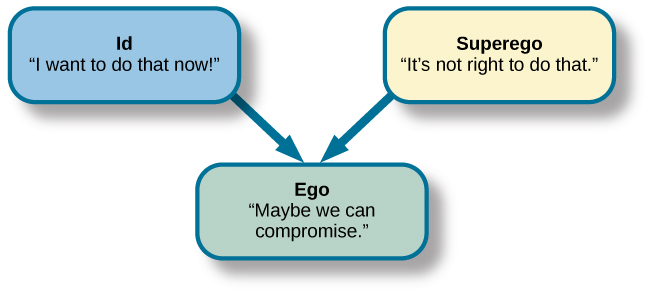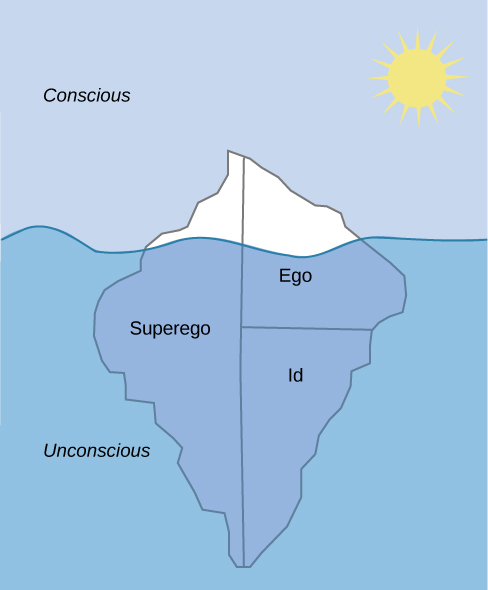5 Personality Theories
Alexandria Lewis

I. Human Development, Diversity, and Behavior in the Environment
1A. Human Growth and Development
KSAs:
– Personality theories
– Psychological defense mechanisms and their effects on behavior and relationships
overview
The following information provides a brief description of behavioral and humanist theories. More details about these theories are included in other chapters.
Source of the following content: 11.2 What Is Personality? is adapted and is shared under a CC BY 4.0 license and was authored, remixed, and/or curated by OpenStax.
Personality refers to the long-standing traits and patterns that propel individuals to consistently think, feel, and behave in specific ways. Our personality is what makes us unique individuals. Each person has an idiosyncratic pattern of enduring, long-term characteristics and a manner in which he or she interacts with other individuals and the world around them. Our personalities are thought to be long term, stable, and not easily changed. The word personality comes from the Latin word persona. In the ancient world, a persona was a mask worn by an actor.
It is important to acknowledge most personality theories in mainstream textbooks are primarily through a Western lens.
Sigmund Freud’s psychodynamic perspective of personality was the first comprehensive theory of personality, explaining a wide variety of both normal and abnormal behaviors. Other major theories then emerged, including the learning, humanistic, biological, evolutionary, trait, and cultural perspectives. In this chapter, we will explore these various perspectives on personality in depth.
psychodynamic
According to Freud, unconscious drives influenced by sex and aggression, along with childhood sexuality, are the forces that influence our personality. Freud attracted many followers who modified his ideas to create new theories about personality. These theorists, referred to as neo-Freudians, generally agreed with Freud that childhood experiences matter, but they reduced the emphasis on sex and focused more on the social environment and effects of culture on personality. The perspective of personality proposed by Freud and his followers was the dominant theory of personality for the first half of the 20th century.
According to Freud, personality develops from a conflict between two forces: biological aggressive and pleasure-seeking drives versus internal (socialized) control over these drives. Personality is the result of efforts to balance these two competing forces. He suggested three interacting systems the id, ego, and superego. The job of the ego, or self, is to balance the aggressive/pleasure-seeking drives of the id with the moral control of the superego.

Note: The following is a dropdown menu.
Levels of Consciousness: Freud believed only about one-tenth of the mind is conscious, and the rest is unconscious. The unconscious refers to mental activity of which a person is unaware and unable to access. According to Freud, unacceptable urges and desires are kept in the unconscious through a process called repression.

Freud believed that people are only aware of a small amount of their mind’s activities and that most of it remains hidden in the unconscious. Thus, the information in the unconscious affects behaviors.
defense mechanisms
Freud believed that feelings of anxiety result from the ego’s inability to mediate the conflict between the id and superego. When this happens, Freud believed that the ego seeks to restore balance through various protective measures known as defense mechanisms. When certain events, feelings, or yearnings cause an individual anxiety, the individual wishes to reduce that anxiety. To do that, the individual’s unconscious mind uses ego defense mechanisms, unconscious protective behaviors that aim to reduce anxiety.
The ego, usually conscious, resorts to unconscious strivings to protect the ego from being overwhelmed by anxiety. When an individual uses defense mechanisms, they are unaware that they are using them. Further, they operate in various ways that distort reality. According to Freud, everyone uses ego defense mechanisms. While everyone uses defense mechanisms, Freud believed that the overuse of them may be problematic.
Self-Check
Select the defense mechanism that best represents the description; there are 15 questions in this activity. The next question will advance automatically after you answer each question.
Additional Resources:
- Khan Academy: Defense Mechanisms
- Agents of Change: Defense Mechanisms
- Positive Psychology: Defense Mechanisms
behavioral
Source of the following content: 2.5: Exploring Behavior is adapted and is shared under a CC BY 4.0 license and was authored, remixed, and/or curated by LibreTexts.
The behavioral perspective is the psychological approach that suggests that the keys to understanding development are observable behavior and external stimuli in the environment. Behaviorism is a theory of learning, and learning theories focus on how we respond to events or stimuli rather than emphasizing internal factors that motivate our actions. These theories provide an explanation of how experience can change what we do.
Behaviorism emerged early in the 20th century and became a major force in American psychology. Championed by psychologists such as John B. Watson (1878–1958) and B. F. Skinner (1904–1990), behaviorism rejected any reference to mind and viewed overt and observable behavior as the proper subject matter of psychology. Through the scientific study of behavior, it was hoped that laws of learning could be derived that would promote the prediction and control of behavior. Russian physiologist Ivan Pavlov (1849–1936) influenced early behaviorism in America. His work on conditioned learning, popularly referred to as classical conditioning, provided support for the notion that learning and behavior were controlled by events in the environment and could be explained with no reference to mind or consciousness.
humanist
Biological
Source of the following content: Explaining Personality: Biological Approaches and Trait Theories is adapted and is shared under a CC BY 4.0 license and was authored, remixed, and/or curated by OpenStax.
Heritability refers to the proportion of difference among people that is attributed to genetics. Findings from the Minnesota Study of Twins Reared Apart study suggest the heritability of some personality traits (i.e., identical twins reared apart had the same chance of being similar as twins raised together). The implication is that some aspects of personalities are largely controlled by genetics; however, it’s important to point out that traits are not determined by a single gene, but by a combination of many genes, as well as by epigenetic factors that control whether the genes are expressed.
Most contemporary psychologists believe temperament has a biological basis due to its appearance very early in an individual’s life. For instance, research suggests babies can be categorized into one of three temperaments: easy, difficult, or slow to warm up. However, environmental factors (family interactions, for example) and maturation can affect the ways in which children’s personalities are expressed.
trait theories
Trait theorists believe personality can be understood via the approach that all people have certain traits, or characteristic ways of behaving.
cultural understanding of personality
Source of the following content: Explaining Personality: Biological Approaches and Trait Theories is adapted and is shared under a CC BY 4.0 license and was authored, remixed, and/or curated by OpenStax.
Culture is transmitted to people through language as well as through the modeling of culturally acceptable and nonacceptable behaviors that are either rewarded or punished. With these ideas in mind, personality psychologists have become interested in the role of culture in understanding personality. They ask whether personality traits are the same across cultures or if there are variations. It appears that there are both universal and culture-specific aspects that account for variation in people’s personalities.
It is essential to consider cultural influences on personality; there is evidence that the strength of personality traits varies across cultures.
The following information about individualist and collectivist should be considered within the context of each person being a unique individual where we have to use caution generalizing.
Individualist cultures and collectivist cultures place emphasis on different basic values. People who live in individualist cultures tend to believe that independence, competition, and personal achievement are important. Individuals in Western nations such as the United States, England, and Australia score high on individualism. People who live in collectivist cultures value social harmony, respectfulness, and group needs over individual needs. Individuals who live in countries in Asia, Africa, and South America score high on collectivism. These values influence personality. Research suggest people in individualist cultures displayed more personally oriented personality traits, whereas people in collectivist cultures displayed more socially oriented personality traits.
Big Five Personality Traits Theory (conscientiousness, neuroticism, openness, and extroversion) across cultures:

